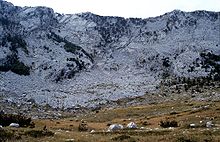Glaziokarst
Glaziokarst is predominantly a form of alpine karst, formerly glaciated or currently glaciated mountains, as well as karst landscapes in sub-polar regions that have no mountain relief and have been shaped by glaciers . The geomorphological forms of the Glaziokarst emerged in different geological epochs. In particular, carts and recent solution and subsidence dolines are being formed. Shapes in the Glaziokarst that existed before the glaciation and were shaped by glaciers are called paleodolines . Subglacial forms that were formed below the glaciers by the activity of the meltwater are jamen .
distribution
Glaziokarst is found in high mountains in karst areas of temperate and subtropical latitudes. In the Alps it is the mountains of the Northern and Southern Limestone Alps. Here in particular the Wetterstein massif, the Berchtesgaden Alps, the Dachstein, the Dead Mountains and the Julian Alps. In the Mediterranean area, there are the Dinarides, in particular the Biokovo, Lovcen, Orjen, Durmitor, Maglic, Velez and Prokletije as well as the central Apennines parts of the Pindus, the Picos de Europa as well as the Taurus and the Lebanon Mountains.
Geomorphology and Formation
If glaciers develop in extremely karstified areas (holokarst), they not only adapt to the karst relief, they develop in them, which leads to so-called karst glaciers . Karst glaciers were first described in 1913 by Jovan Cvijić from Prokletije in the Dinarides . Known among the recent karst glaciers are those of the Dachstein Mountains .
Glaziokarst is used when a karst area glaciated over a large area in the Pleistocene and karstification was usually only activated after the glaciers had melted. This resulted in mixed forms of glacial erosion and karst landscapes, which occur over a large area in the Karwendel limestone Alps , the Orjen high Dinarides , the Taurus , in the Picos de Europa , the Pyrenees or the Western Caucasus.
Since Glaziokarst occurs predominantly in high mountains with strong relief, typical manifestations are mostly to be found in alpine stages. If, as in the subtropical Orjen , areas below 1000 m also show features of the glacial karst, these are caused by low-lying snow lines in the Pleistocene, which led to far-reaching glacial phenomena. Characteristics are flat sinkholes , layered stairs, large vertical shafts (caused by glacial melt ) and diverse small forms on typical glacial forms such as the Roche moutonnée and boulders .
In northern Europe, glacial karst landscapes can also be found on leveled limestone surfaces that were previously covered by the inland ice.
Individual evidence
- ↑ Varess, Márton 2016: Postglacial Evolution of paleodepressions in glaciokarst Areas of the Alps and Dinarides . Journal of Geomorphology 60/4: 343-358
- ↑ Varess, Márton: p. 344
- ↑ Varess, Márton: pp. 343-344
- ↑ Žebre, M., Stepišnik, U. 2015: Glaciokarstic landforms and processes of the southern Dinaric Alps. - Earth Surfaces and Landforms 40 (11): 1493-1505
literature
- Varess, Márton 2010: Karst Environments - Karren Formation in High Mountains. Springer, Heidelberg. ISBN 978-90-481-3549-3
- Varess, Márton 2016: Covered Karst. Springer, Dordrecht. ISBN 978-94-017-7516-8
- Varess, Márton 2013: .A GLACIÁLIS FELSZÍNTÍPUSOK KARSZTOSODÁSA [KARSTIFICATION OF GLACIAL SURFACE TYPES]. Földrajzi Közlemények 137/1: 2-27.



